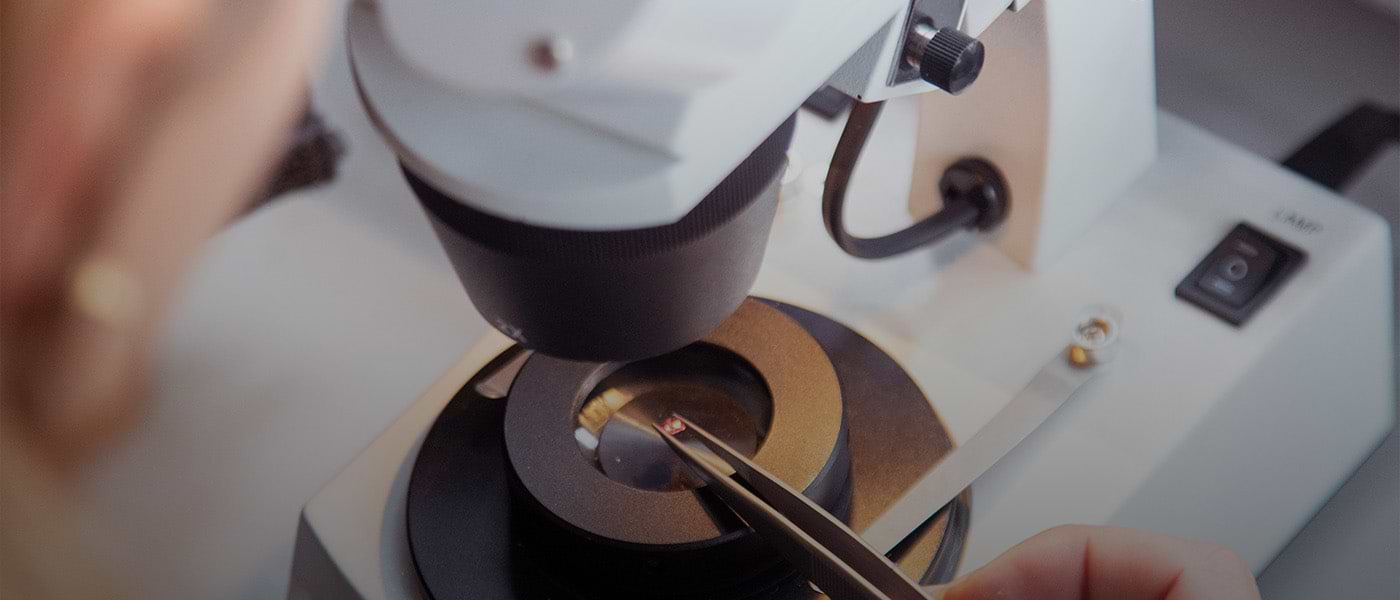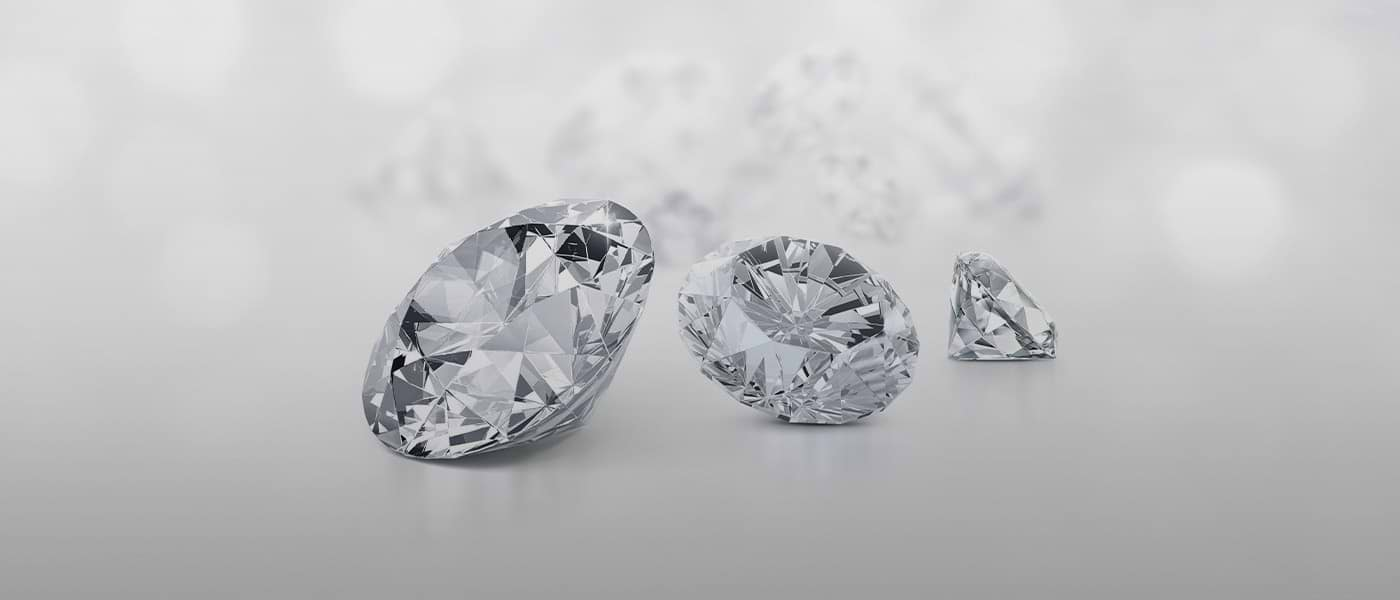Learn About the 4C's
Originally created by the Gemological Institute of America (GIA), the GIA International Diamond Grading System was developed to standardize how diamonds are graded across the world. Diamonds are graded based off the 4Cs – cut, color, clarity, and carat weight.

Choosing the right diamond starts by understanding these characteristics and how they relate to each unique stone. Use this guide to familiarize yourself with the 4Cs and learn how these four essential diamond characteristics can inform your stone selection process.
What is Diamond Cut?
A diamond’s cut does not refer to its shape, but determines how well it captures and refracts light through the balance, proportion, and symmetry of its facets. It is one of the most important factors that determine the beauty, brilliance, and fire of a diamond. A well-cut diamond creates a sparkling and dazzling effect, while a poor-cut one will appear dull and dark even if they have a high grade of color or clarity.
Types of Diamond Cuts
Diamond cuts are graded on a scale that goes from Ideal to Poor.
- Ideal Cut diamonds have outstanding sparkle and flawless symmetry. They are cut to perfect proportions for refracting light.
- Excellent Cut diamonds have exceptional sparkle and even patterns
- Very Good Cut diamonds have great sparkle and polish. They are considered symmetrical.
- Good Cut diamonds have a fine sparkle. They have a reasonable level of polish and symmetry.
- Fair Cut diamonds have a low level of sparkle and polish. They are not always symmetrical.
- Poor Cut diamonds appear dim and asymmetrical, with uneven spots on their surface
Brilliance, Dispersion, Fire & Scintillation
Any well-cut diamond will have four key characteristics: brilliance, dispersion, fire, and scintillation.
- Brilliance refers to the light reflected off a diamond’s surface. Whenever light hits the surface of a diamond, it will either reflect off the surface or enter the stone. A well-cut diamond will allow the light to reflect rather than enter, creating a stunning shiny appearance
- Dispersion occurs when light rays separate into flashes of color after hitting the surface of the diamond.
- Fire is the result of dispersion. White light separates into the spectral colors of the rainbow, creating a fiery appearance on the diamond’s surface.
- Scintillation are the flashes of color that are visible whenever the diamond is in motion. It is the play between the fire and whiteness inside the facets of the diamond.
All four of these elements come together in a well-cut diamond, no matter what its shape is, to create a magnificent and beautiful sparkle.

What is Diamond Color?
Diamond color refers to the presence or absence of color in a diamond. The most valuable diamonds are those that are completely colorless. The Gemological Institute of America (GIA) grades diamond color on a scale from D (colorless) to Z (light yellow or brown).
- The GIA color scale is as follows:
- D, E, F: Colorless
- G, H, I, J: Near colorless
- K, L, M: Faint yellow
- N, O, P: Very light yellow
- Q, R, S, T: Light yellow
- U-Z: Light yellow or Brown
A colorless diamond is almost pure white, while lower grades have a yellowish tint. This is caused by the trace element of nitrogen. Completely colorless diamonds are considered to be chemically pure and structurally perfect; imperfections and impurities are what cause color variations within diamonds.
It’s interesting to note that diamonds are actually available in every color of the rainbow. However, colorless or white diamonds are traditionally the most valuable. Jewelers recommend choosing a stone with the least amount of color possible if you’re looking to stick to tradition.
Color is often considered the second most important C, since it can make a big impact on the value of the diamond.
Differences in color are very difficult to determine to an untrained eye. Generally, you won’t be able to see a difference unless the diamonds are two color grades apart, and even then, it will depend on the position of the diamond. If a diamond is face up, which it likely will be, the naked eye won’t see any color. You may see traces of color from the diamond’s side profile, which will probably be partially hidden by the ring mount.

Should You Set Your Diamond According to Color?
The color of your diamond can influence the metal you choose for your setting. You want to choose a metal that best complements the hue of your stone.
- Colorless diamonds pair well with platinum, palladium, or white gold. The pure whiteness of colorless diamonds creates a cool tone that looks best with silvery metals. Choosing a cool metal will accentuate the diamond’s purity of color.
- Near colorless diamonds pair well with white, yellow, or rose gold. Mostly white, these versatile diamonds look great against any type of gold setting. The warm colors of yellow and rose gold will do a good job of making any color traces less noticeable.
- Faint colored diamonds pair well with yellow or rose gold. The warmth of yellow and brown undertones in faint colored diamonds looks best against equally warm metals.
What are Fancy Colored Diamonds?
Even though white or colorless diamonds are the most traditional, diamonds are available in a variety of colors, known as fancy colored diamonds.
Color rarity is the determining factor of a fancy colored diamond. The stronger and purer the color is, the more valuable the diamond will be. The most valuable colored diamonds are pink and blue. Yellow diamonds are not as rare, but they are still treasured for their warmth and golden tones.
Fancy colored diamonds still have a grading scale, but it is different to colorless diamonds. The system rates their hue, tone, and saturation.
- Hue defines the main color of the stone
- Tone evaluates the lightness or darkness of the stone
- Saturation describes the intensity of the hue
The stone’s color level is determined by the tone and saturation, which is then graded on a scale that runs from lightest to darkest. The exact scale is:
- Lightest
- Faint
- Very Light
- Light
- Fancy Light
- Fancy
- Fancy Intense
- Fancy Vivid
- Fancy Dark
- Fancy Deep
The diamonds are then described with their hue. For example, a light blue diamond would be called a Fancy Light Blue Diamond, while a vivid pink diamond would be called a Fancy Deep Pink Diamond.
Fancy Deep diamonds are considered the most valuable, but those that prefer pastel shades can find soft colors that fit their aesthetic in the light range.
What is Diamond Clarity?
Diamond clarity refers to the presence or absence of blemishes and inclusions within a diamond. Blemishes are imperfections on the diamond surface, while inclusions are internal imperfections. Clarity can affect the diamond’s brilliance and value.
The Gemological Institute of America (GIA) has created a standard grading system for diamond clarity that ranges from Flawless (FL) to Included (I3). Some grades have different categories within the grade, like Very Very Slightly Included 1 and Very Very Slightly Included 2. The higher the number after the grading, the more inclusions will be visible on and within the diamond.
- Flawless (FL). No imperfections or inclusions on the diamond’s surface. This is the rarest and most valuable type of diamond.
- Internally Flawless (IF). No visible imperfections or inclusions on the diamond’s surface, even under magnification. Although the diamond appears flawless, it still may have very minor inclusions that are difficult to see.
- Very Very Slightly Included 1 (VVS1) & Very Very Slightly Included 2 (VVS2). No visible imperfections or inclusions to the untrained eye. Minor inclusions may be visible under magnification.
- Very Slightly Included 1 (VS1). Small imperfections or inclusions may be visible under close inspection.
- Very Slightly Included 2 (VS2). More minor imperfections or inclusions may be visible.
- Slightly Included 1 (SI1), Slightly Included 2 (SI2) & Slightly Included 3 (SI3). Small imperfections and inclusions are visible, even to an untrained eye.
- Included 1 (I1), Included 2 (I2) & Included 3 (I3). Imperfections and inclusions are clearly visible.
It's important to choose a diamond with no inclusions if you're after a diamond that’s look will not detract from the diamond's overall brilliance and durability. Stick with diamonds rated "VS2" or higher if you want to be certain that your diamond is absolutely free of "eye-visible” imperfections, which are imperfections that can be seen without magnification.
All diamonds are graded based on their clarity. Grading is determined by closely examining the diamond under 10X magnification. A gemologist will note the quantity, relief, and placement of inclusions to identify the clarity grade.
Can a Diamond Shape Affect its Clarity?
The shape of a diamond can affect its clarity because certain shapes hide inclusions and blemishes better than others.
Brilliant cut shapes, such as round and princess, are better at hiding imperfections than step-cut shapes, such as emerald and asscher. The large, open tables of step-cut shapes make inclusions more visibly noticeable, while the high level of facets in a brilliant cut make inclusions more difficult to spot. This isn’t to say step-cut diamonds should be avoided. You’ll just need to opt for step-cut stones with a higher clarity grade.
Generally, the best diamond shapes for hiding inclusions are brilliant cuts in round, cushion, oval, radiant, or pear forms. You can choose diamonds with clarity grades as low as SI1 or SI2 with these shapes.
What is Diamond Carat?
Diamond carat refers to the weight of a diamond and is measured in carats. One carat is equal to 0.2 grams or 200 milligrams and is subdivided into 100 “points”. This ensures an ultra precise measurement to the hundredth decimal place. Typical diamond weights range from 0.25 carats to 5 carats.
The term carat is derived from the word carob, which refers to the carob seed that was used as a standard of weight for ancient traders.
The carat weight of a diamond determines how big it is and the price of a diamond tends to increase with its carat weight, as heavier diamonds are rarer and more valuable. Up to two- carat weight may be lost when raw diamonds are cut and polished into finished thirds of the total diamonds.
Carat only determines the weight of a diamond. Size is affected by a number of other factors such as, shape, weight distribution, and cut quality. This means that two diamonds of the same carat weight can be different sizes.
Carat Vs. Karat
It is important to not confuse carat, which measures a diamond’s weight, with karat, the term given for determining the purity of gold.
Both terms are relevant to diamond ring shopping, since the piece will have carats and karats. For example, a 1ct diamond ring in 14K gold means that the ring’s diamond weighs 1 carat and is set in 14K gold.

